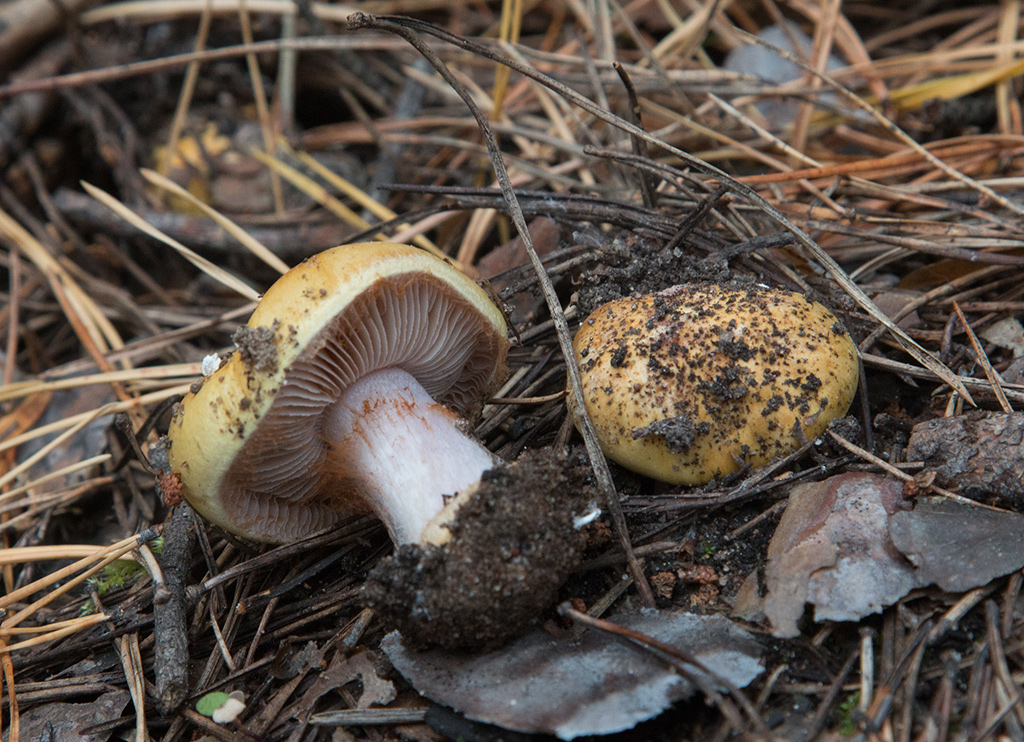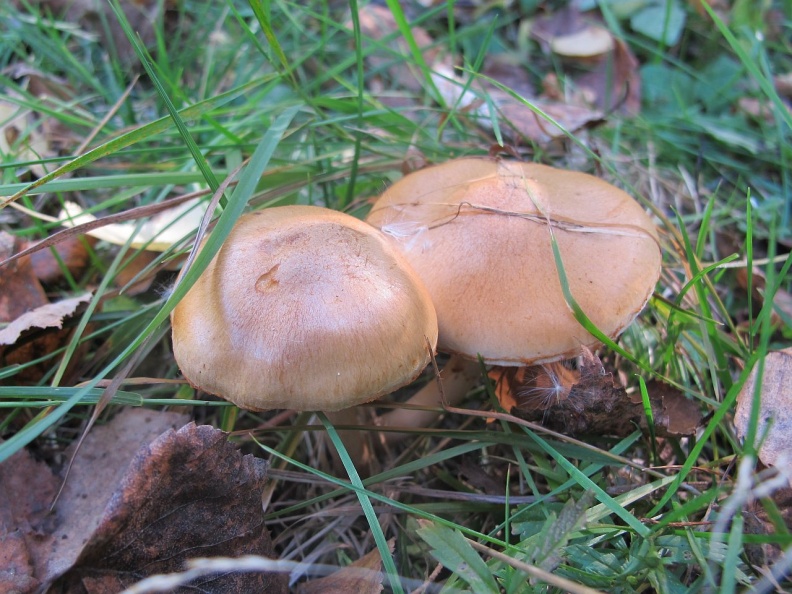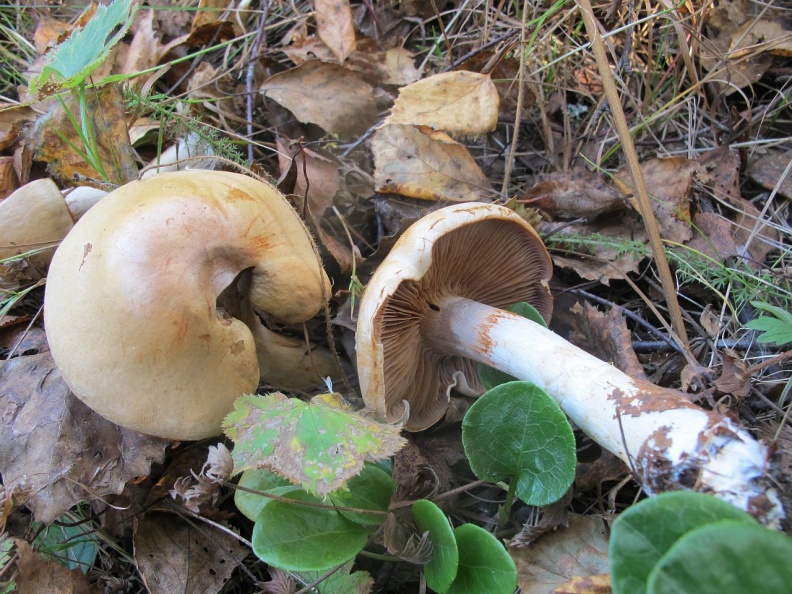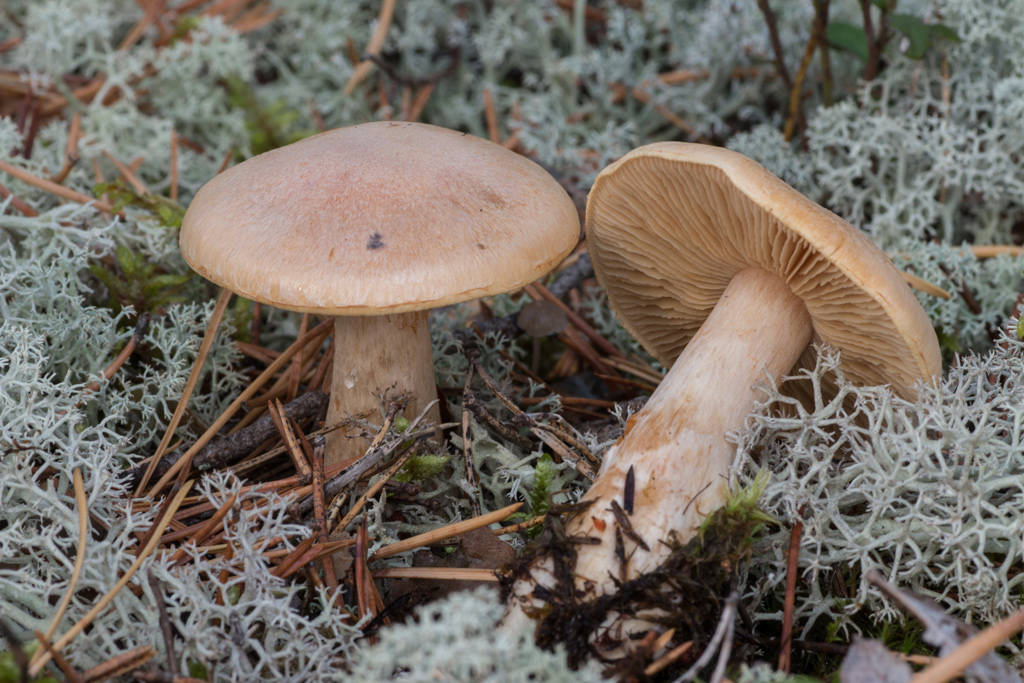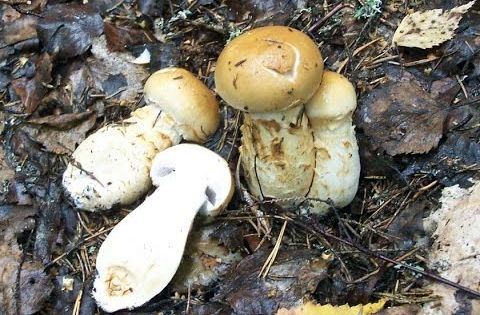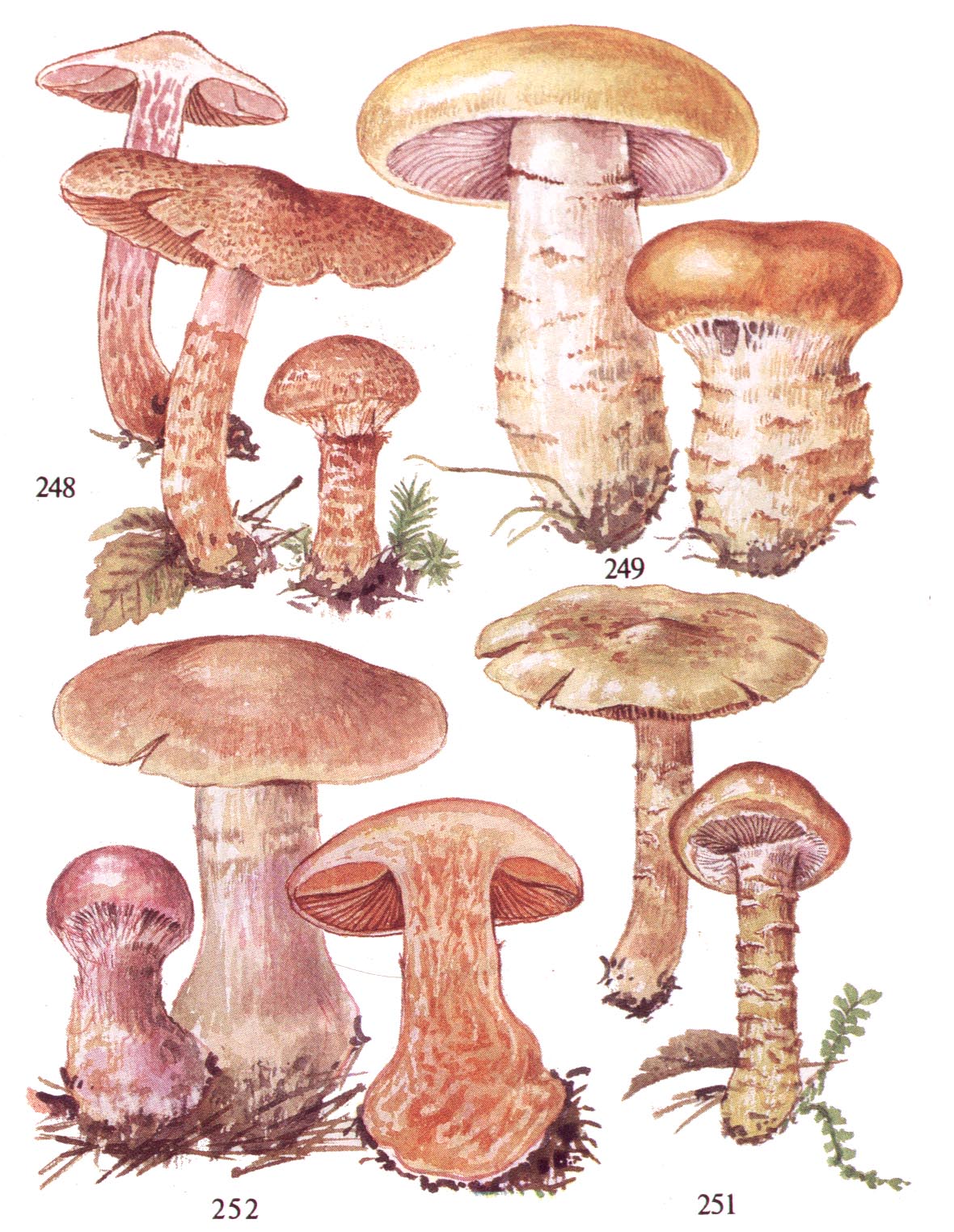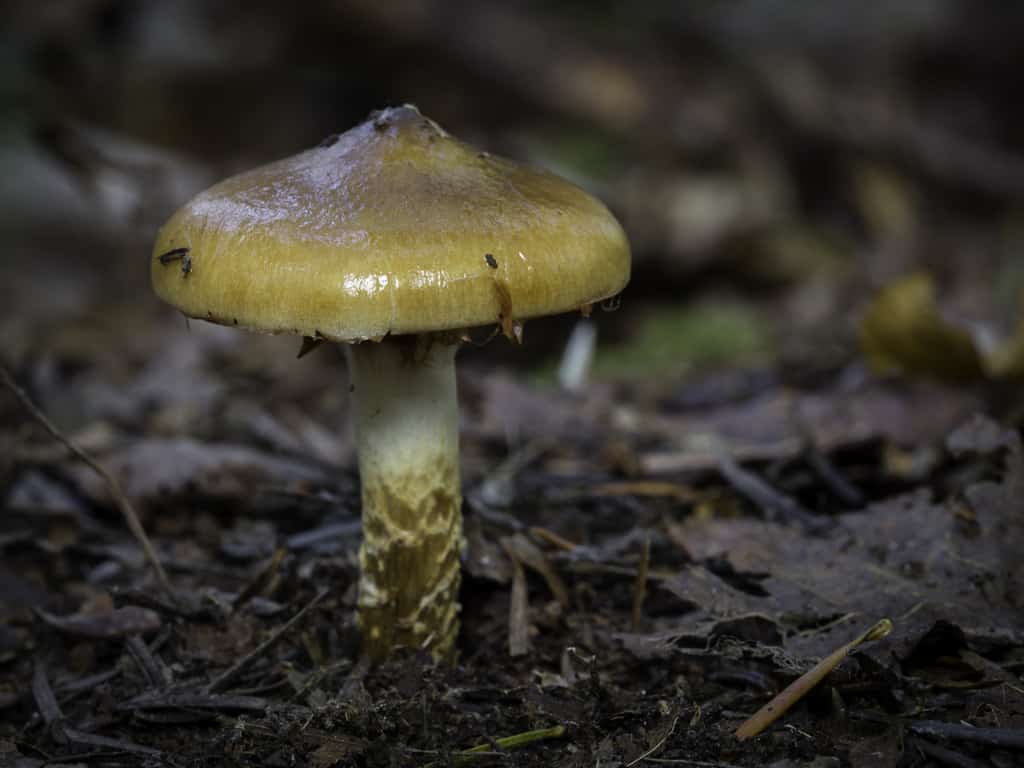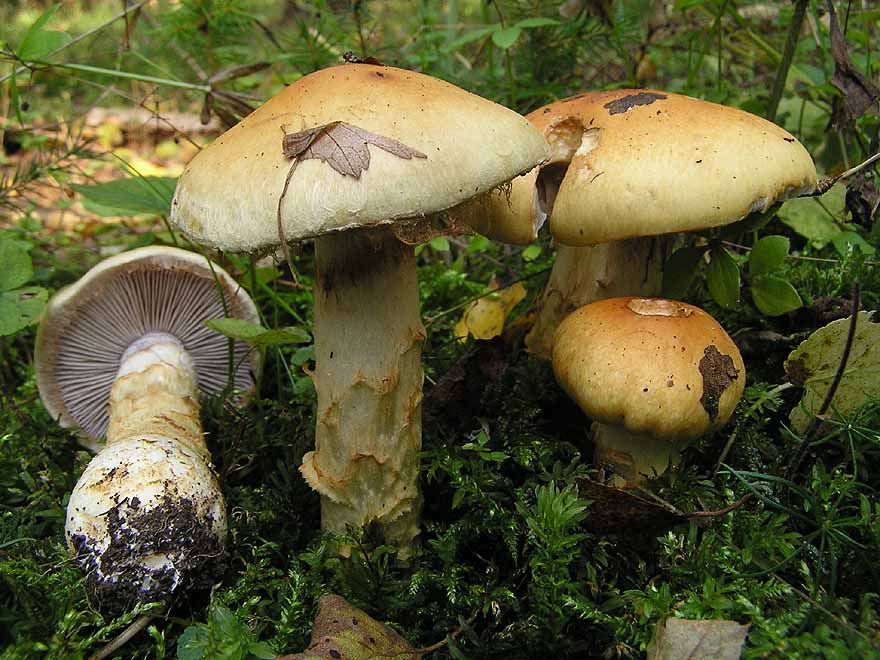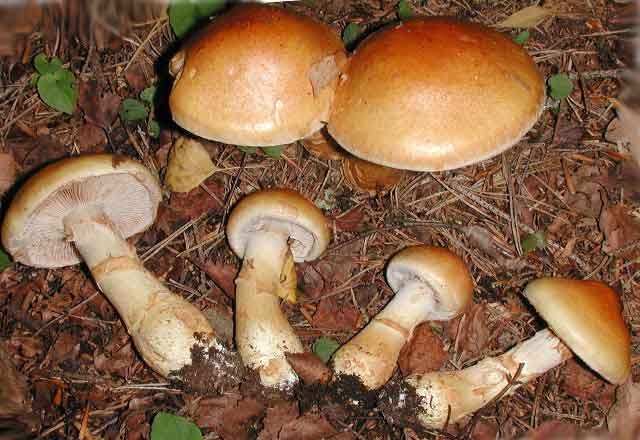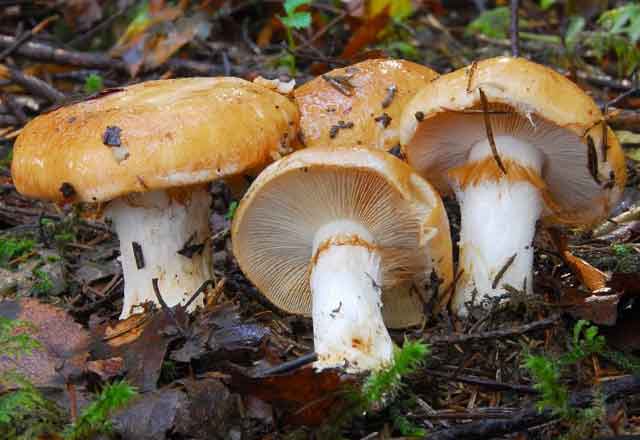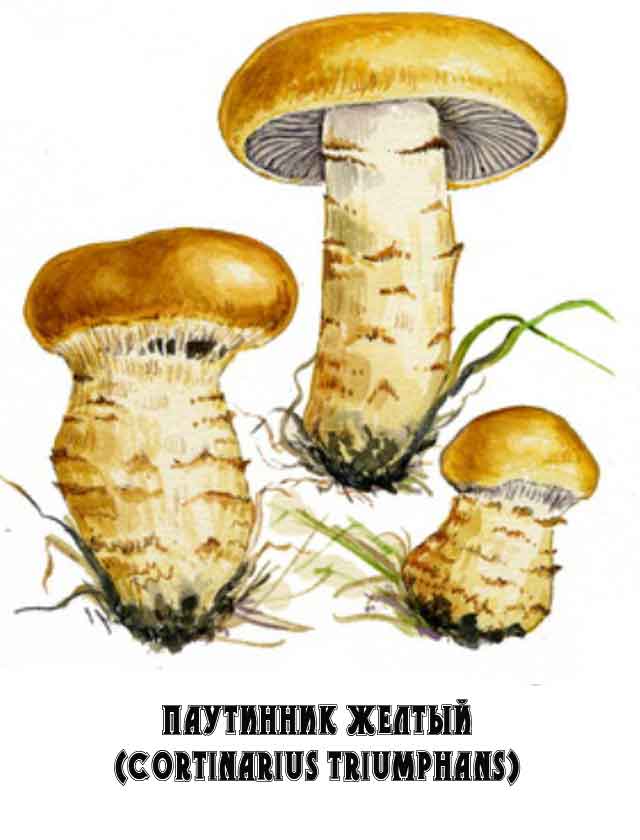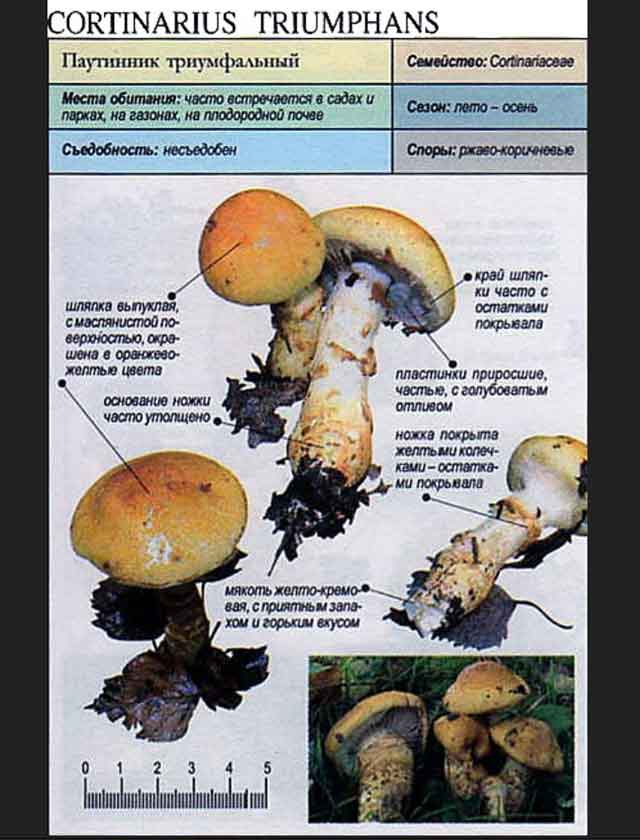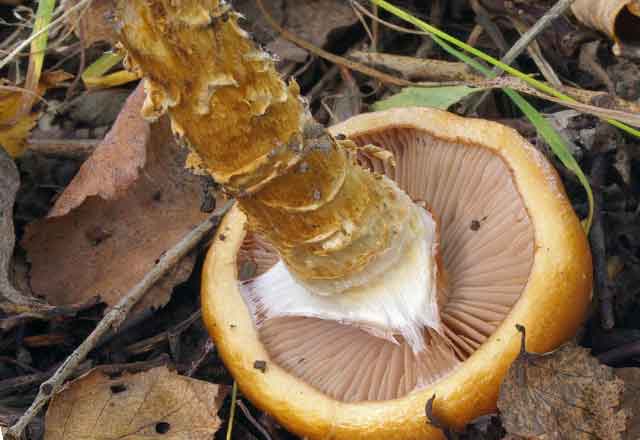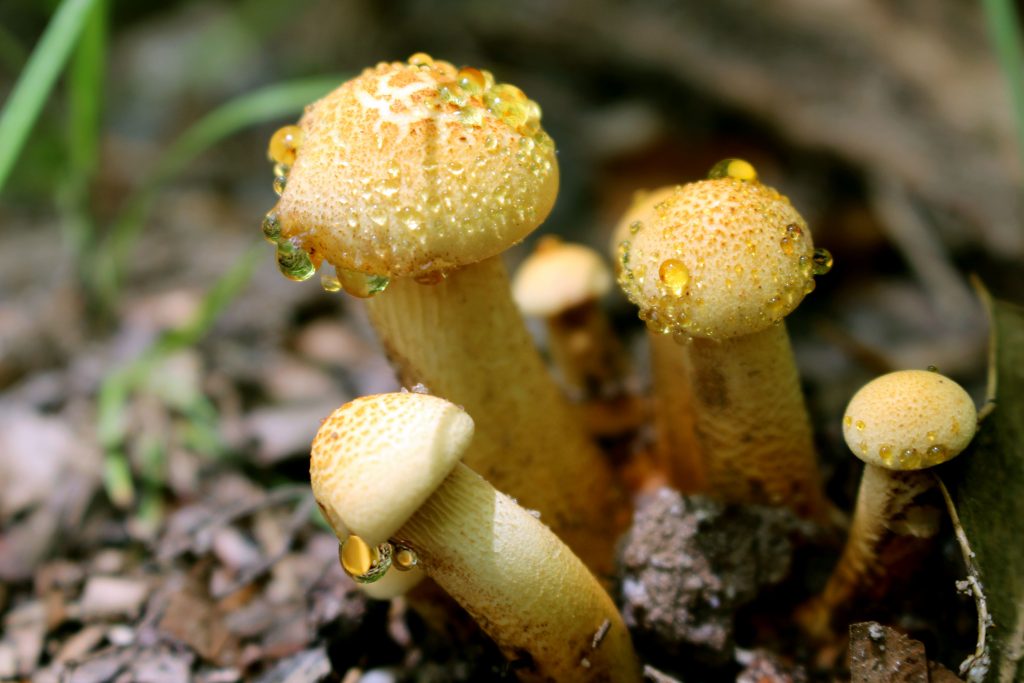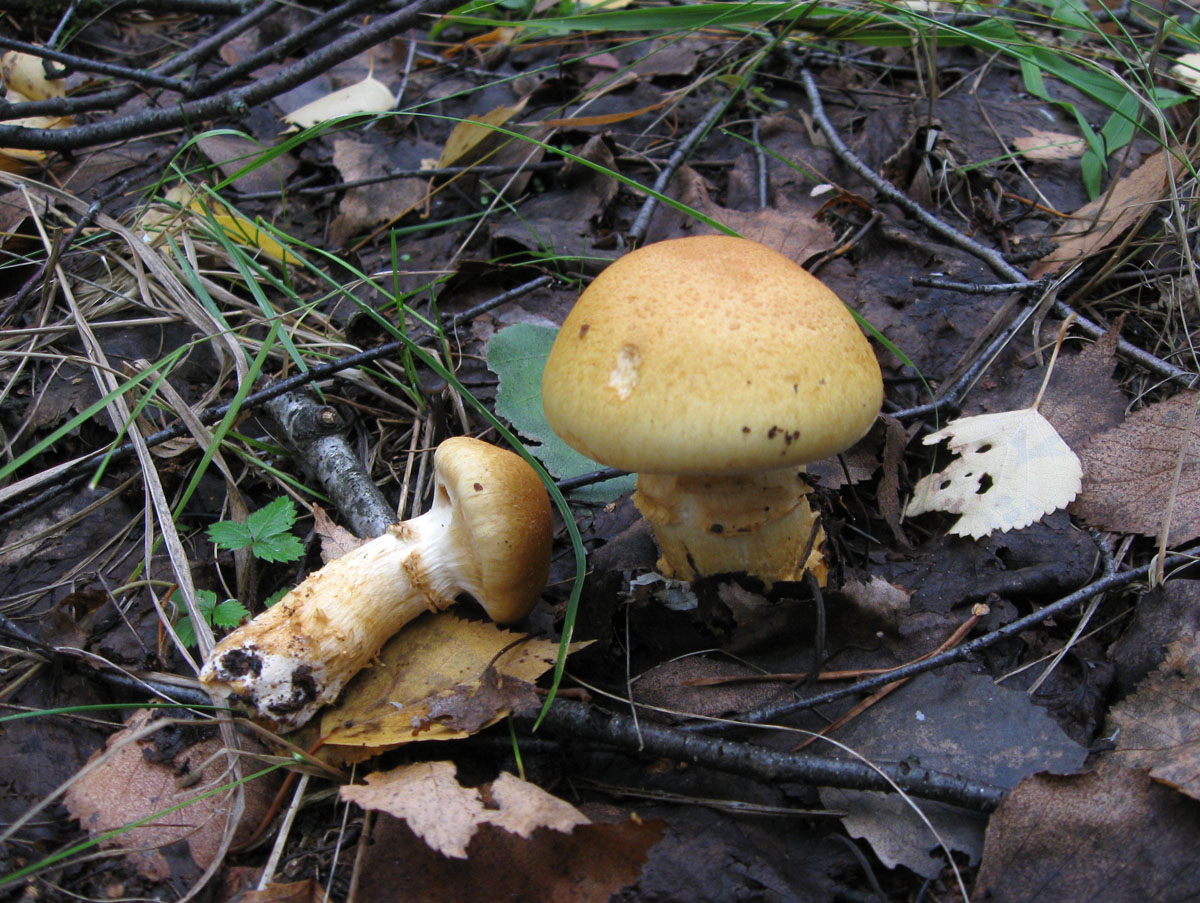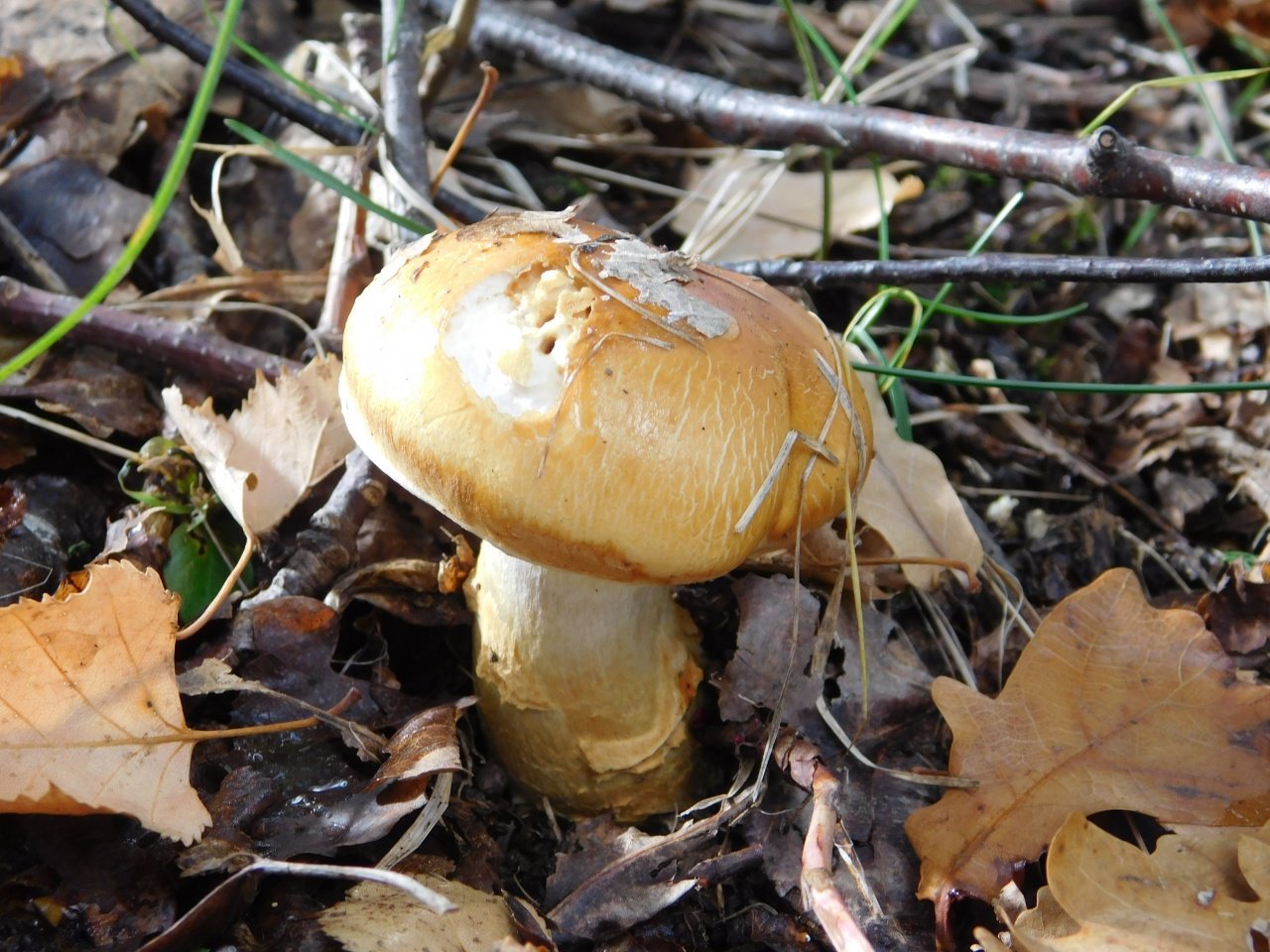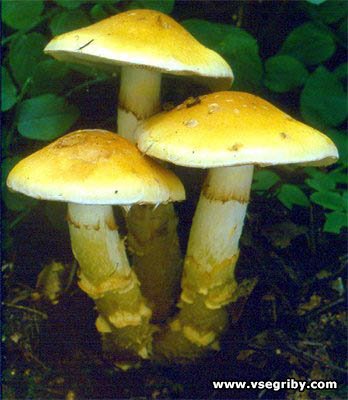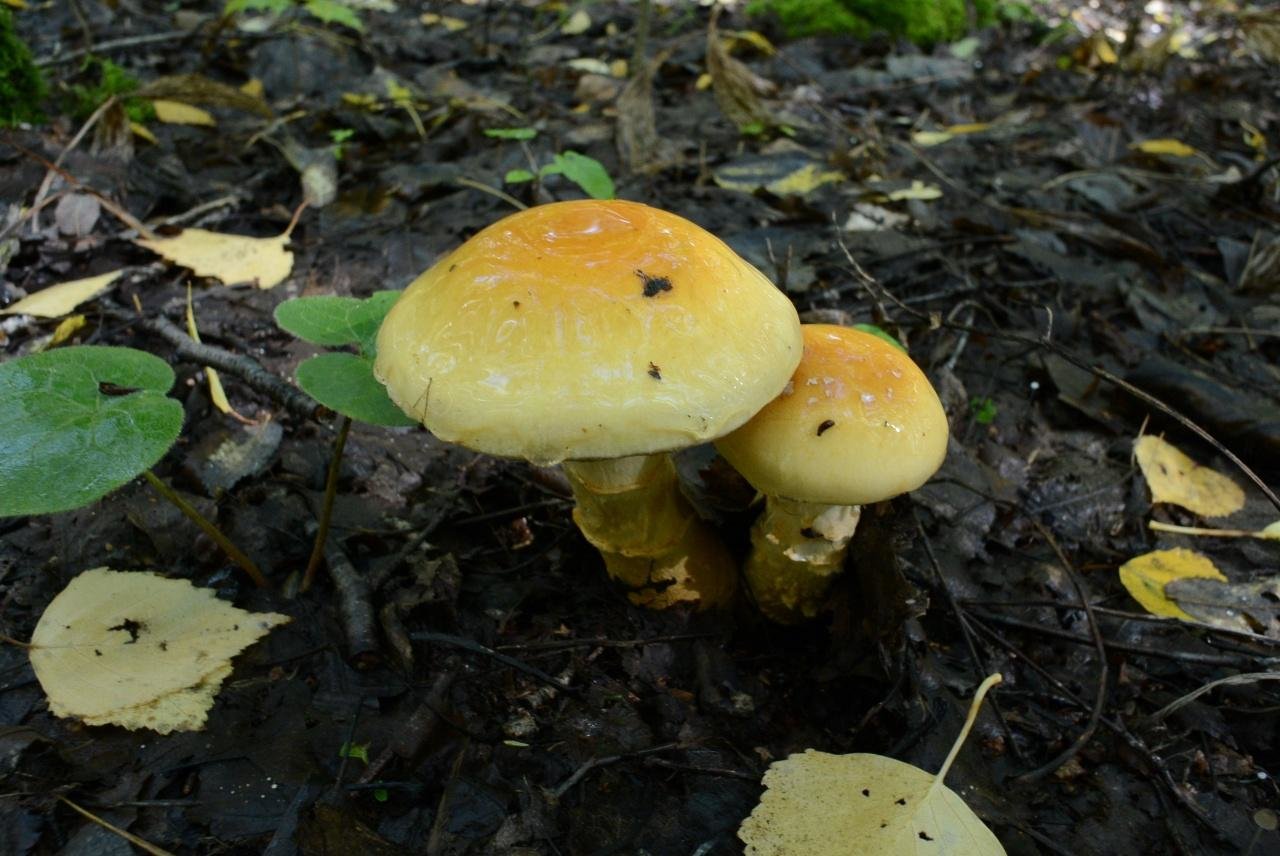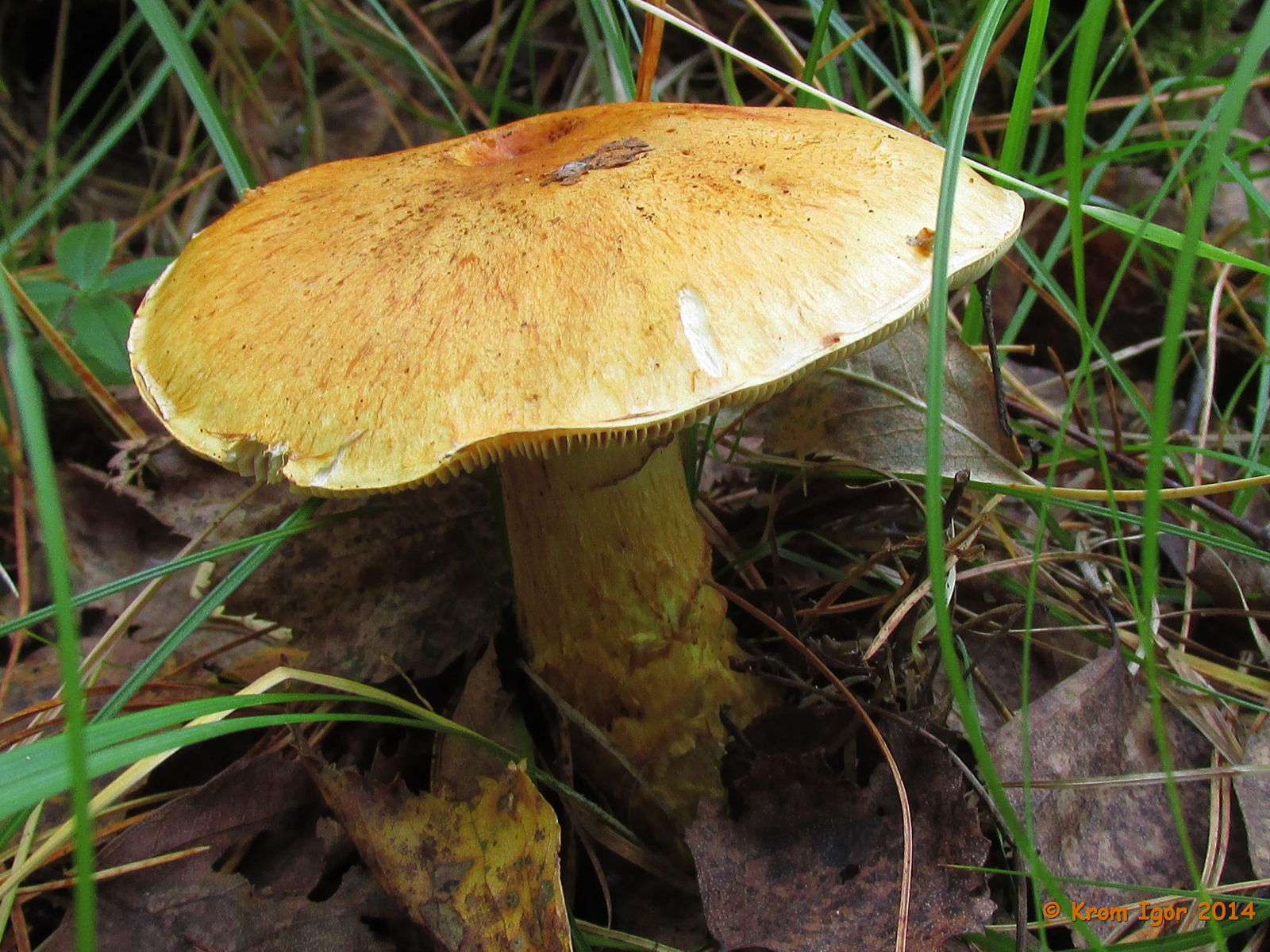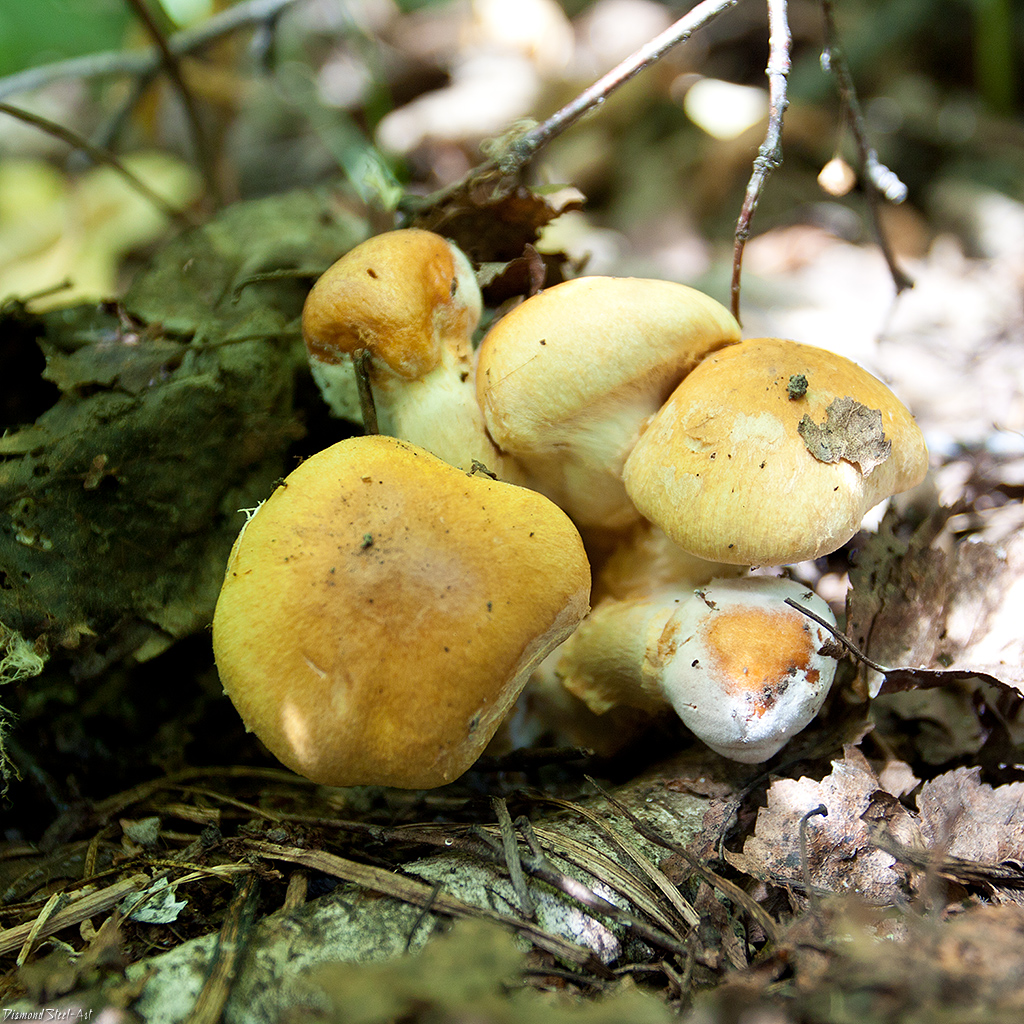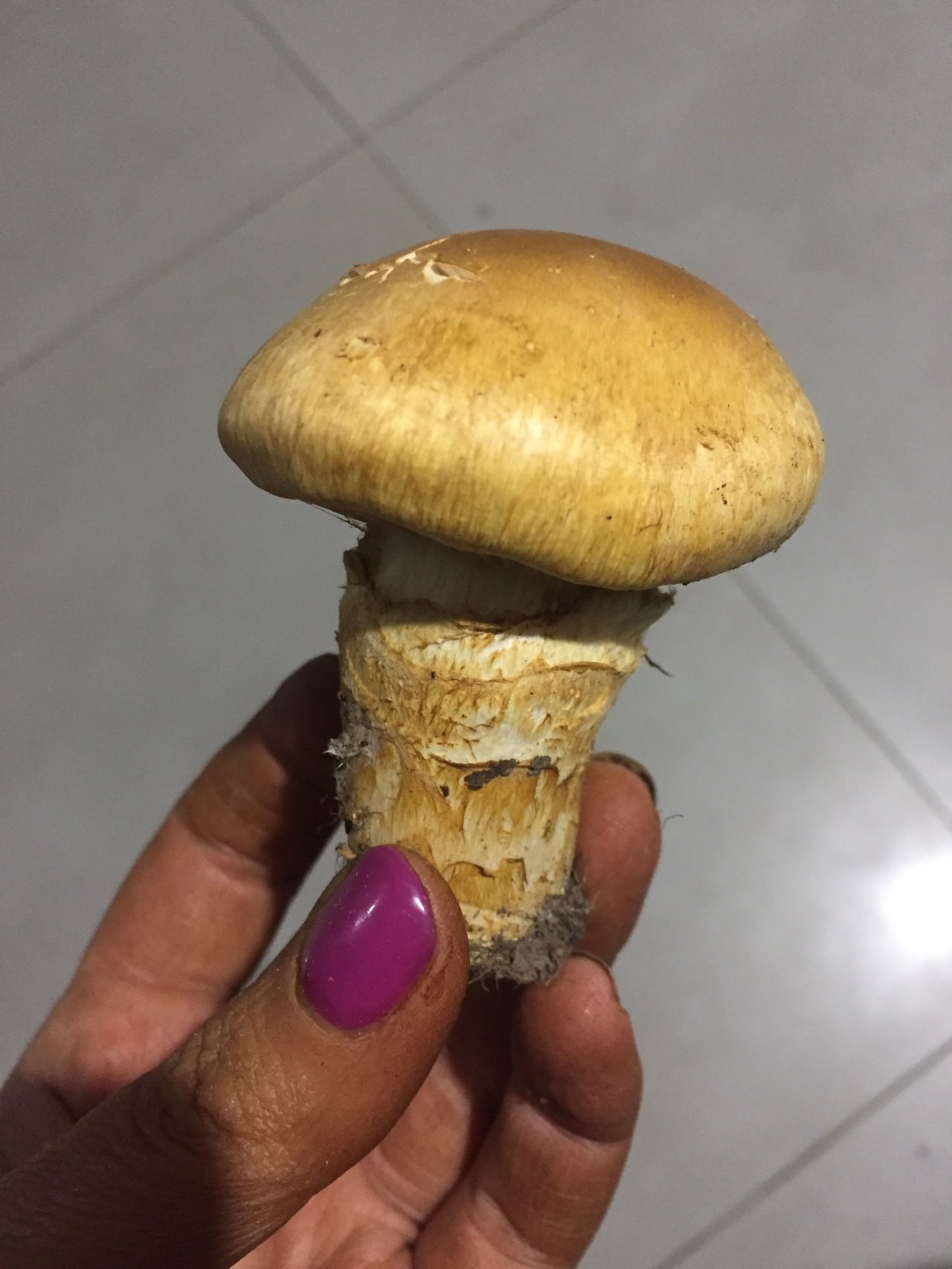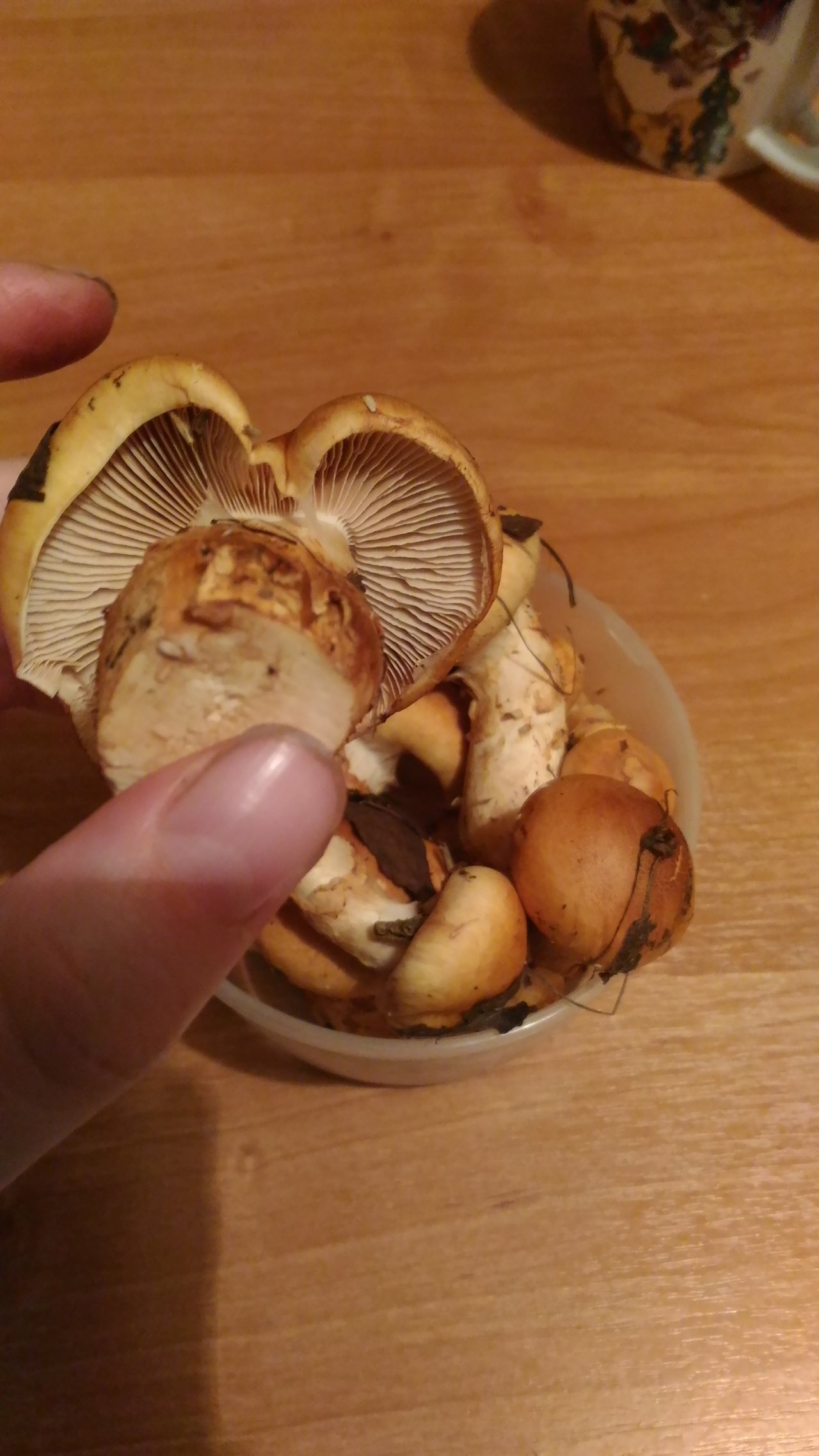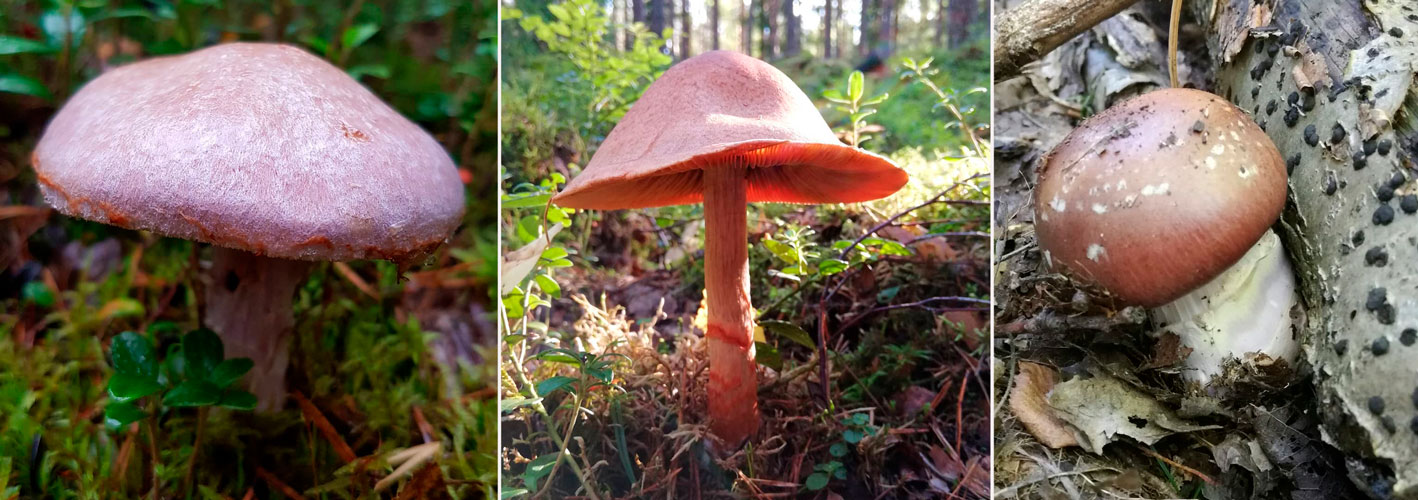Description
Yellow spiderweb (Cortinarus triumphans), also known as triumphal spiderweb, triumphal spiderweb, yellow spiderweb, is a mushroom belonging to the genus Cortinarius of the Spiderweb family (Cortinariaceae). If a number of foreign sources classify it as inedible, then domestic researchers not only classify the yellow spider web as conditionally edible, but also consider it the most delicious representative of Cortinarius.

The mushroom looks like this:
- the cap is initially hemispherical, then becomes convex-outstretched, painted in yellow-brown or orange tones, its surface is oily, with remnants of a cobweb blanket at the edges;
- the pulp is fleshy, yellow-cream in color, with a bitter taste and a delicate mushroom smell;
- the plates are frequent, adherent, with a gray-bluish tint in young mushrooms and beige-brown in old ones;
- spores in the form of an ellipse, rusty brown;
- the leg at the beginning of the growth of the fruiting body is strongly expanded at the base (tuberous), then cylindrical, 1.5-2 cm thick, reaches a length of up to 15 cm, dense, pale yellow, with brighter ring-shaped scaly belts - the remains of the bedspread.
Gallery: types of cobwebs (45 photos)
Webcap yellow
Cortin.triumрhans - has a hemispherical or cushion-shaped, half-open upper part of an orange-yellow coloration with the remnants of a bedspread and a sticky or dry surface covering a thick, soft, whitish-yellowish pulp with a pleasant aroma. The plates are weakly adherent, narrow and frequent, light smoky-cream or bluish-brown in color with a rusty-reddish-brown spore powder. The lower part of the fruiting body is strongly thickened, cylindrical in shape.
Webcap yellow
Webcap white-purple
Cortin.albоviolaceus - has a rounded bell-shaped, convex or convex-outstretched cap with an elevation in the central part and a silky fibrous, shiny, smooth, sticky surface of lilac-violet-silver or white-lilac coloration. Plates are medium-frequent, narrow, grayish-blue, gray-ocher or brownish-brown, with the presence of rusty-reddish-brown spore powder. The area of the leg is clavate, with weak mucous membrane. The soft part is thick and watery in places, gray-blue, brownish, with an unpleasant odor.
Webcap white-purple
Bracelet webcap
Cortin.armillatus - has a hemispherical, gradually opening, cushion-shaped cap with a wide and obtuse tubercle in the central part, covered with dry and fleecy, orange or reddish-brown coloration with remnants of a red-orange-brown blanket. The soft part is thick and dense, brownish in color, with a pronounced musty odor in the absence of mushroom taste. Plates of an adherent type, wide and relatively sparsely located, grayish-cream, slightly brownish or rusty-brown in color, with brown-rusty-red spore powder. The lower part of the fruiting body is lighter, widening at the base, with bracelet-like remains of the veil.
Bracelet webcap
The webcap is special
Cortin.rubellus - has a conical or prostrate-conical cap, with a sharp tubercle in the center and a fine-scaly, reddish-orange, reddish-orange or bright brownish surface, covering the tasteless and radish-smelling flesh of a reddish-orange-orangish tinge. Thick and wide plates are rare, growing to the stem, orange-ocher or rusty-brownish in color, with rusty-reddish-brown, spherical spores with roughness. The lower part of the fruiting body is cylindrical, of sufficient density.
Also read: What do the mushrooms lines look like and where do they grow
Scaly webcap
Cortin.pholideus - has a bell-shaped, slightly convex, with a blunt elevation in the center and numerous scales of a dark brown coloration of the cap, covered with a pale brown, brownish-brown skin. It is distinguished by rare, grayish-brownish plates with a lilac-violet tint and the presence of a brown spore powder. The lower part of the fruiting body is cylindrical or weakly clavate, with an extension at the base, solid or hollow, with a smooth, grayish-brownish scaly surface. Loose type, gray-violet-brownish flesh has a faint musty odor.
Scaly webcap
Webcap noble
Cortin.géntilis - is distinguished by a hygrophane, conical, bell-shaped, convex, with an elevation in the center, a silky-fibrous or velvety-felt cap of a yellowish-reddish-brown or reddish-brown, ocher-orange or yellowish-ocher coloration with the presence of appressed scales. Plates of an adherent type, descending, rarely located wide and thick, light yellow-ocher or dark brown in color. The lower part of the fruiting bodies without thickening at the base, hollow, covered with a whitish coating, fibrous type, reddish-buffy in color.
Webcap noble
Webcap abnormal
Cortin.anomalus - differs in convexity or flat, with a dry silky or smooth surface, a cap of grayish-brown, bluish-violet, reddish-brown or brown color. The area of the leg is cylindrical, with a thickening towards the base, whitish, with a light fibrous partial veil. The soft part is whitish, with a purple tint, odorless, with a mild taste.
Definitioner
- rare (rare smell)
-
In mycology, a rare smell, English. "Raphanoid", is interpreted very loosely and often denotes any smell of raw root vegetables, including potato, ie. not necessarily as sharp, sharp, and crisp as black or white radish.
- Basidia (Basidia)
-
Lat. Basidia. A specialized structure of sexual reproduction in fungi, inherent only in Basidiomycetes. Basidia are terminal (end) elements of hyphae of various shapes and sizes, on which spores develop exogenously (outside).
Basidia are diverse in structure and method of attachment to hyphae.
According to the position relative to the axis of the hypha, to which they are attached, three types of basidia are distinguished:
Apical basidia are formed from the terminal cell of the hypha and are located parallel to its axis.
Pleurobasidia are formed from lateral processes and are located perpendicular to the axis of the hypha, which continues to grow and can form new processes with basidia.
Subasidia are formed from a lateral process, turned perpendicular to the axis of the hypha, which, after the formation of one basidium, stops its growth.
Based on morphology:
Holobasidia - unicellular basidia, not divided by septa (see Fig. A, D.).
Phragmobasidia are divided by transverse or vertical septa, usually into four cells (see Fig. B, C).
By type of development:
Heterobasidia consists of two parts - hypobasidia and epibasidia developing from it, with or without partitions (see Fig. C, B) (see Fig. D).
Homobasidia is not divided into hypo- and epibasidia and in all cases is considered holobasidia (Fig. A).
Basidia is the place of karyogamy, meiosis and the formation of basidiospores. Homobasidia, as a rule, is not functionally divided, and meiosis follows karyogamy in it. However, basidia can be divided into probasidia - the site of karyogamy and metabasidia - the site of meiosis. Probasidium is often a dormant spore, for example in rust fungi. In such cases, probazidia grows with metabasidia, in which meiosis occurs and on which basidiospores are formed (see Fig. E).
See Karyogamy, Meiosis, Gifa.
- Pileipellis
-
Lat. Pileipellis, skin - differentiated surface layer of the cap of agaricoid basidiomycetes. The structure of the skin in most cases differs from the inner flesh of the cap and may have a different structure. The structural features of pileipellis are often used as diagnostic features in descriptions of fungi species.
According to their structure, they are divided into four main types: cutis, trichoderma, hymeniderma and epithelium.
See Agaricoid fungi, Basidiomycete, Cutis, Trichoderma, Gimeniderm, Epithelium.
Description of the cobweb yellow
A young spider web has a hemispherical cap, while its lower part is covered with a whitish film. Later, the cap opens and takes on a convex-flat shape, and the edges become wavy. Its diameter can be up to 2 centimeters. The color of the cap is bright yellow, the edges are lighter than the center.
There are wide plates under the yellow cap. They are located often. The edges of the plates are uneven. At first, the color of the plates is pale yellow, and over time they acquire an ocher color.
The flesh of the triumphal cobweb is fleshy, thick, dense. The color of the pulp is off-white. The pulp of the yellow pistil has a pleasant mushroom aroma.

The leg is thick. In youth, its shape is tuberous, later it becomes cylindrical with a wider base. A fibrous ring sits under the cap on the leg, and closer to the base there are several more yellow rings. The surface of the leg is dry.
Places of growth of triumphal cobwebs and the time of their fruiting
In our forests, spider webs of this species are observed quite often, and they grow abundantly. Often triumphal cobwebs can be found in birch forests and conifers. There is a small chance of seeing the mushroom at the edge of the forest, next to lakes and swamps. This representative of the mushroom kingdom prefers bright places. Fruiting bodies can be found among forest floor or grass.
The first fruiting bodies of yellow spider webs appear at the beginning of August, they can be found until October. Massively these pimples bear fruit in September, when black mushrooms grow. If there are a large number of black mushrooms in the forest, then yellow cobwebs will surely grow nearby.

How to recognize a cobweb
About 40 species of spider webs grow in our forests. Almost all species are edible, but poisonous ones can also come across. The webcap differs in that at a young age it has a film between the leg and the edge of the cap. Over time, the film separates into thin threads, similar to cobwebs. In mature mushrooms, the cobweb disappears.
Young spider webs have a strong resemblance, so it is not easy to determine their edibility, this is subject only to experienced mushroom pickers. And beginners are advised not to pick dubious or unknown mushrooms.
Similar species and how to distinguish
The outlines and proportions of the fruiting body are most similar to the representatives of their species, with the following characteristic differences:
- Cortinarius cliduchus - a darker color of the cap, he prefers alkaline soils, his symbionts are hard trees;
- Cortinarius olidus - does not form mycorrhiza with birch, its cap is darker, the veil is brownish-olive;
- Cortinarius anserinus (goose) - inedible, its smell resembles plum.
Poisonous species are also found among the spider webs, but they are easy to distinguish from the spiderweb by an unpleasant odor, bright color of the leg, and more elongated proportions of fruit chalk.
Edible mushrooms, berries, herbs
Orange-red webcap (Cortinarius orellanus)
The orange-red webcap is also called a plush webcap or a mountain webcap. You can meet him from the last decade of August to the last decade of October in broad-leaved (where there is a birch oak) and coniferous forests. It prefers to grow singly and in groups on sandy soil. More common in the southern regions of Russia.
The hat is from 4 to 8 cm in diameter, at first it has a hemispherical shape, then it is convex-outstretched or flat with a lowered edge. The surface is dry, matte, felt, fine-flaked, orange-red-brown in color with a darker center.There is a small tubercle in the central part of the cap.
The plates are sparsely located, wide, thick, adherent have a color similar to the color of the cap. On very young specimens, there is a cobweb cover of a yellowish-ocher color, which disappears very early.
The leg is cylindrical, sometimes slightly narrowed towards the base, 5-10 cm long and up to 2 cm in diameter. The structure is longitudinally fibrous (covered with dark fibers inherited from a torn bedspread), without belts, has a light yellow color on the main part. Above, the leg is lemon-yellow, at the base it is rusty-brown.
The pulp is yellowish-brown, tasteless, with a faint unpleasant odor, vaguely resembling a radish.
The orange-red webcap is recognized as a deadly poisonous mushroom. Its main insidiousness lies in the fact that the main symptoms of poisoning appear 5-14 days after consumption. Poisonous toxins (orellanins) are completely retained during cooking, frying or drying. The first symptoms of poisoning are unbearable thirst, then sharp pains in the abdomen appear, later pathological changes in the work of the kidneys occur. If the poisoned person is lucky and survived, then further treatment can last up to a year or more.
The mountain webcap can be confused with similar types of brown-red webcaps: the most beautiful poisonous webcap, brown webcap, dark brown webcap, edible bracelet. Since even edible species do not taste good, it is better to refuse to eat all more or less suspicious specimens.
Photos of orange-red spiderweb (Cortinarius orellanus)
To better recognize this poisonous mushroom, it does not hurt to watch the video of the Italian Mycological Association about the Orange-red Webcap
Description of the mushroom
The common webcap, called in Latin Cortinarius trivialis, belongs to the family of Webcaps (or Cortinaria) and the genus Webcaps (agaric order). It is popularly known as Pribolotnik, as it grows mainly in wet areas. It acquired its name thanks to a kind of cobweb blanket, reminiscent of a veil-like film, which connects the edges of the cap with the leg. And the epithet "ordinary" symbolizes the classic, usual structure of the fruiting body and inexpressive color.
The cap of the mushroom reaches a diameter of 3 to 8 cm. In immature representatives of the species, it has a hemispherical, rounded-bell-shaped shape with curved edges. As the fungus grows, it becomes convex-outstretched with a wide, low tubercle in the center. At the same time, a small amount of mucus can be seen on the surface of the cap. The color varies from pale yellow or pale ocher with an olive tint to clay, honey brown and yellow brown. There are also fruiting bodies with a red-brown cap in the center and light edges.
The hymenophore (the lower part of the cap, on the surface of which there is a thin spore-bearing layer) is distinguished by wide, often located to each other, plates that grow together in the form of a tooth. In young mushrooms, this part has a yellow or whitish color, and in more mature ones, it is rusty brown or pale ocher. Also on the hymenophore, a barely noticeable cobweb cover of a whitish color with a mucous consistency is visible. The spore powder in the common spider web is yellowish-brown.
On the cut, the flesh of the mushroom is quite dense, ocher color (sometimes it acquires a light whitish tint), and closer to the base of the leg it becomes slightly brownish. The smell of the fruiting body is unpleasant, and the taste is inexpressive.
The leg of the common spider web is silky and dense. It has a cylindrical shape that tapers or sometimes widens towards the base. Its height is 5-10 cm, and its diameter is no more than 1-2 cm.In young representatives of the species, it is initially solid, and later becomes complete. The color of the leg is white, sometimes with a purple tint, brownish in the base area. The girdle on the stem resembles concentric fibers of yellow-brown and brown shades.
Description of the mushroom
The cobweb, yellow or triumphal, belongs to the genus of cobwebs of the cobweb family. The Latin name is Cortinarius triumphans. You can often find another name for it - triumphal pribolotnik.
The mushroom is listed in the Red Book of Moscow and the Moscow Region. In other regions of the Russian Federation, it occurs quite often and in large groups.
The cap of the triumphal cobweb grows up to 12 cm in diameter, at first it is hemispherical, then becomes convex, less often flat. The surface of the mucous membrane is bright, often yellow or ocher, becomes reddish or brown with age, lighter at the edges than in the center.
The lower part of the cap is called the hymenophore. In a triumphant cobweb, it is lamellar, adherent, the location is frequent. The color at a young age is bluish, creamy, then it becomes more brown, and the edge brightens. Spores are rusty brown.
The pulp is thick, fleshy, does not change color on the cut, the tone is creamy, there is no special taste or smell. An alkali solution causes it to turn yellow.
The leg grows up to 15 cm high and 2.5 cm thick. Its shape is cylindrical, it can slightly expand in the lower part. The color is yellow, covered with well-identifiable scaly bands.
A bit of history
In 1838, the Swedish botanist and mycologist Elias Magnus Fries first gave a full description of it and included it in the genus to which the podolotnik still belongs to this day.
Classification and representatives
Main article: Taxa of the genus Spiderweb
On the basis of macroscopic, microscopic and chemical characters, the genus is divided into 4-7 taxa, which were previously considered as subgenera or sections; in new systems, subgenera are divided into a large number of sections.
In 1821 E. Fries divided the genus into 6 subgenera: Myxacium, Phlegmacium, Inoloma (= Cortinarius sensu stricto), Dermocybe, Telamonia and Hydrocybe... Moser in 1955, taking the Fries system as a basis, identified 5 independent genera, but he (together with Singer) in 1962 again lowered their rank to subgenera, with changes in their composition.This classification is also adopted in new systems, but the assignment of species to subgenera can vary considerably among different authors.
Cortinarius - one of the largest genera of the Agarikov order. Different authors indicate a different number of species in the genus, usually up to 700, but according to the most complete edition - "Dictionary of mushrooms", the number of species exceeds 2000.
Subgenera (according to Nezdoyminy (1996), corresponds to the Moser - Singer system (1962)):
- Phlegmacium (Fr.) Fr.
- Sericeocybe P.D. Orton
- Myxacium (Fr.) Loud.
- Telamonia (Fr.) Loud.
- Leprocybe Mos.
- Cortinarius
- Dermocybe (Fr.) Sacc.
Some species:
| Cat. * | Latin name | Russian name | ||||||||||
|---|---|---|---|---|---|---|---|---|---|---|---|---|
| Cortinarius alboviolaceus | Webcap white-purple | |||||||||||
| Cortinarius balteatocumatilis | Webcap bluish belted | |||||||||||
| Cortinarius anomalus | The webcap is abnormal | |||||||||||
| Cortinarius anserinus | Goose webcap | |||||||||||
| Cortinarius armillatus | Bracelet webcap | |||||||||||
| Cortinarius auroturbinatus | Beautiful clubfoot webcap | |||||||||||
| Cortinarius bolaris | Lazy webcap, or red-scaly, or hulk webcap | |||||||||||
| Cortinarius camphoratus | Webcap camphor | |||||||||||
| Cortinarius cinnamomeus | Cinnamon webcap | |||||||||||
| Cortinarius collinitus | Blue-bore webcap | |||||||||||
| Cortinarius cotoneus | Wadded webcap | |||||||||||
| Cortinarius crassus | Thick-fleshy webcap | |||||||||||
| Cortinarius cumatilis | Spider web is watery blue, or gray-blue | |||||||||||
| Cortinarius elegantior | The webcap is elegant | |||||||||||
| Cortinarius elegantissimus | The most elegant webcap | |||||||||||
| Cortinarius evernius | The webcap is brilliant | |||||||||||
| Cortinarius herculeus | Webcap of Hercules | |||||||||||
| Cortinarius largus | The webcap is large, or abundant | |||||||||||
| Cortinarius limonius | Cobweb lion-yellow | |||||||||||
| Cortinarius mucosus | Slimy webcap | |||||||||||
| Cortinarius multiformis | Diverse webcap | |||||||||||
| Cortinarius odorifer | Anise webcap | |||||||||||
| Cortinarius orellanus | Mountain webcap, or plush, or orange-red, or poisonous | |||||||||||
| Cortinarius paleaceus | Filmy webcap | |||||||||||
| Cortinarius phoeniceus | Cobweb purple | |||||||||||
| Cortinarius pholideus | Scaly webcap | |||||||||||
| Cortinarius praestans | The webcap is excellent | |||||||||||
| Cortinarius purpurascens | The webcap is crimson, or reddish | |||||||||||
| Cortinarius rubellus | Reddish cobweb | |||||||||||
| Cortinarius rufoolivaceus | Red & olive spiderweb | |||||||||||
| Cortinarius sanguineis | Webcap blood red | |||||||||||
| Cortinarius semisanguineus | Webcap half-blood red | |||||||||||
| Cortinarius sodagnitis | The cobweb is recognizable | |||||||||||
| Cortinarius speciosissimus | The webcap is beautiful | |||||||||||
| Cortinarius splendens | The webcap is shiny | |||||||||||
| Cortinarius terpsichores | Webcap of Terpsichore | |||||||||||
| Cortinarius torvus | Gloomy webcap | |||||||||||
| Cortinarius traganus | Goat's webcap, or lilac thick-legged | |||||||||||
| Cortinarius triumphans | Triumphal webcap | |||||||||||
| Cortinarius trivialis | Common webcap | |||||||||||
| Cortinarius variecolor | Multi-colored webcap | |||||||||||
| Cortinarius varius | Changeable webcap, or brick-yellow | |||||||||||
| Cortinarius violaceus | Webcap purple | |||||||||||
|
Cinnamon webcap
The webcap is dark brown;
Cinnamon spiderweb (Cortinarius cinnamomeus) is a type of mushroom belonging to the Spiderweb family, the Spiderweb genus. This mushroom is also called brown spider web, or dark brown spider web.
The brown webcap is also called the species Cortinarius brunneus (dark brown webcap), which is not related to this.
External description
The cinnamon webcap has a cap with a diameter of 2-4 cm, characterized by a hemispherical convex shape. Over time, the cap becomes open. In its central part there is a noticeable obtuse tubercle. The surface of the cap is dry to the touch, fibrous in structure, yellowish brownish brown or yellowish olive brown in color.
The mushroom stem is characterized by a cylindrical shape, initially well filled on the inside, but gradually becomes hollow. In girth, it is 0.3-0.6 cm, and in length it can vary from 2 to 8 cm. The color of the leg is yellowish-brown, lightening towards the base. The pulp of the mushroom has a yellow tint, sometimes turning into olive, it does not have a strong smell and taste.
The fungal hymenophore is represented by the lamellar type, consists of adherent yellow plates, gradually becoming brownish-yellow. In color, the plates are similar to a mushroom cap. They are thin in structure, often located.
Season and habitat
The cinnamon spider web begins to bear fruit in late summer and continues to harvest throughout September. Grows in deciduous and coniferous forests, widespread in the boreal zones of North America and Eurasia. Occurs in groups and singly.
Edibility
The nutritional properties of this type of mushroom are not fully understood. The unpleasant taste of the cinnamon spiderweb pulp makes it unfit for human consumption. This mushroom has several related species, which differ in their poisonousness. However, no poisonous substances were found in the cinnamon spider web; it is absolutely safe for human health.
Similar types and differences from them
One of the types of mushrooms similar to the cinnamon spider web is the saffron spider web. Their main difference from each other is the color of the hymenophore plates in young fruit chalk. In cinnamon cobweb, the plates have rich orange hues, and in saffron, the color of the plates tends to be more yellow. Sometimes there is confusion with the name of the cinnamon spider web. This term is often called a dark-brown spider web (Cortinarius brunneus), which is not even one of the species related to the described spider web.
An interesting fact is that the cinnamon spider web has the properties of dyeing materials. For example, with the help of its juice, you can easily dye wool in a rich burgundy red.
conclusions
Before preparing a dish of cobwebs, boil them thoroughly, changing the water several times. However, only experienced mushroom pickers will be able to cope with such an unbearable task as determining which of the types of cobwebs this or that mushroom belongs to.
The thing is that they are very similar to each other and an unknowing person can quite simply confuse an edible representative with a dangerous toxic relative.
In some cases, they lead to pathological changes in the body, and sometimes even death. In case of mushroom poisoning, you should immediately provide the victim with first aid in the form of washing the stomach and intestines, and also provide plenty of fluids to avoid dangerous dehydration.
But even the most poisonous mushrooms do not lose their medicinal properties. They contain substances from which, with the right technology in the laboratory, you can extract various components that are used to create antibiotics and various other drugs.
In fact, the spiderweb is a rather valuable mushroom, but it is valued mainly for its medical indicators. Its taste and culinary properties are not very popular. Cobwebs are quite rare and little-known mushrooms, so it is better not to take risks and refuse to eat them, in favor of other edible, more tasty and well-known representatives.
More fresh and relevant health information on our Telegram channel. Subscribe: https://t.me/foodandhealthru


